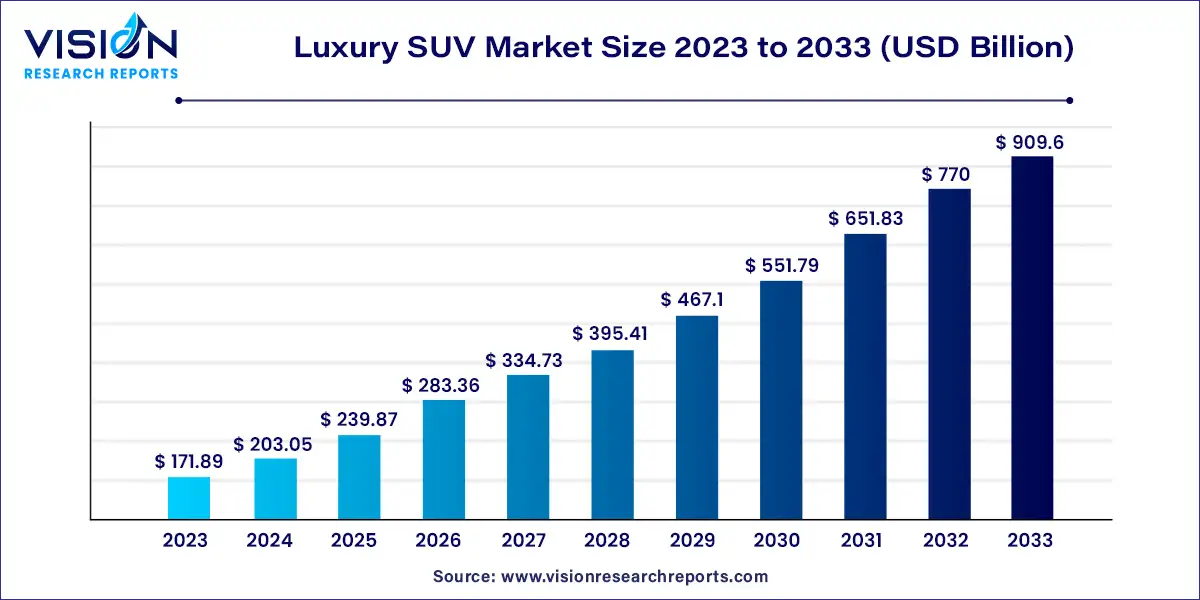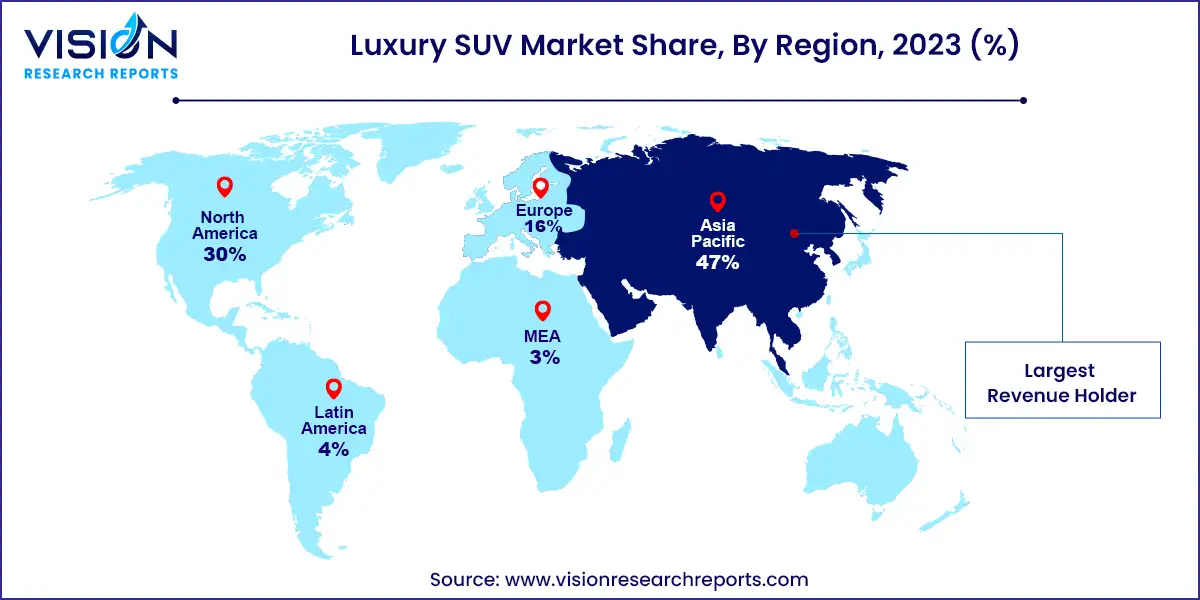The global luxury SUV market size was estimated at around USD 171.89 billion in 2023 and it is projected to hit around USD 909.6 billion by 2033, growing at a CAGR of 18.13% from 2024 to 2033.

The luxury SUV market has experienced significant growth over the past decade, driven by increasing consumer demand for high-end, versatile vehicles that offer both performance and comfort. Luxury SUVs combine the ruggedness and utility of traditional SUVs with the opulence and advanced technology of luxury cars, catering to affluent buyers who seek a premium driving experience.
The luxury SUV market is experiencing robust growth due to the rise in disposable income among consumers, particularly in emerging markets, has led to increased spending on premium vehicles. As people achieve higher income levels, the demand for high-end, versatile vehicles like luxury SUVs has surged. Secondly, technological advancements have significantly enhanced the appeal of luxury SUVs. Innovations such as advanced driver-assistance systems, state-of-the-art infotainment options, and improved fuel efficiency make these vehicles highly attractive to affluent buyers. Thirdly, there is a noticeable shift in consumer preferences towards SUVs over traditional sedans. This preference is driven by the superior comfort, spacious interiors, and elevated driving position that SUVs offer.
In 2023, the luxury SUV market in Asia Pacific dominated, accounting for 47% of global revenue. Key market drivers include the rapid rise in affluence and the expanding middle class in countries like China and India. Additionally, the aspiration for global brands and the influence of Western lifestyles enhance the appeal of luxury SUVs. High-end brands are perceived as status symbols, driving demand among affluent consumers in the region.
| Attribute | Asia Pacific |
| Market Value | USD 80.78 Billion |
| Growth Rate | 18.13% CAGR |
| Projected Value | USD 427.51 Billion |
The luxury SUV market in North America is projected to grow steadily from 2024 to 2033. The region's cultural preference for larger vehicles, especially SUVs, is strong. Consumers favor luxury SUVs for their spacious interiors, advanced features, and versatility, which cater to both family needs and personal preferences.

The luxury SUV market in the U.S. is expected to grow at a significant CAGR from 2024 to 2033. The U.S. market features diverse consumer demographics, including young professionals, families, and retirees, each with unique preferences. Luxury SUVs cater to these varied needs by offering a wide range of models and features.
In 2023, the mid-size SUV segment led the market, capturing 45% of global revenue. This segment appeals to consumers looking for a balance between advanced features and luxury. Manufacturers are enhancing the cabin experience with high-quality materials, ergonomic designs, and advanced climate control systems, which are expected to drive segment growth. Additionally, the option for buyers to personalize their vehicles with various trims, color choices, and accessory packages adds to the allure of mid-size SUVs, contributing to their growth over the forecast period.
The compact SUV segment is anticipated to experience substantial growth from 2024 to 2033. These vehicles are increasingly equipped with state-of-the-art technology, including Advanced Driver Assistance Systems (ADAS), connectivity features, and infotainment systems. These technological enhancements attract tech-savvy consumers who prioritize innovation in their driving experience. Furthermore, the rise of Internet of Things (IoT) and connected car technologies, such as remote diagnostics, over-the-air updates, and in-car internet connectivity, further boosts the demand for compact SUVs.
The ICE segment dominated the market in 2023, driven by the superior performance and power these vehicles offer. Luxury SUV consumers often prioritize robust engine performance and high horsepower, attributes exemplified by models like the Porsche Cayenne and Mercedes-Benz G-Class. These vehicles are renowned for their powerful engines, delivering an exhilarating driving experience that electric models have yet to fully replicate.
The electric segment is expected to witness significant growth from 2024 to 2033, influenced by stringent government regulations and incentives promoting electric vehicles. Policies aimed at reducing carbon emissions are motivating manufacturers to develop cleaner and more efficient luxury SUVs. Increased regulatory pressures and incentives are accelerating the global adoption of electric and hybrid vehicles. According to a European Environment Agency (EEA) report, the transition to electric and hybrid vehicles has markedly reduced greenhouse gas emissions, with electric SUVs alone cutting CO2 emissions by an estimated twenty million tons annually, contributing to the EU’s climate goals.
By Vehicle Type
By Propulsion Type
By Region
Chapter 1. Introduction
1.1. Research Objective
1.2. Scope of the Study
1.3. Definition
Chapter 2. Research Methodology
2.1. Research Approach
2.2. Data Sources
2.3. Assumptions & Limitations
Chapter 3. Executive Summary
3.1. Market Snapshot
Chapter 4. Market Variables and Scope
4.1. Introduction
4.2. Market Classification and Scope
4.3. Industry Value Chain Analysis
4.3.1. Raw Material Procurement Analysis
4.3.2. Sales and Distribution Channel Analysis
4.3.3. Downstream Buyer Analysis
Chapter 5. COVID 19 Impact on Luxury SUV Market
5.1. COVID-19 Landscape: Luxury SUV Industry Impact
5.2. COVID 19 - Impact Assessment for the Industry
5.3. COVID 19 Impact: Global Major Government Policy
5.4. Market Trends and Opportunities in the COVID-19 Landscape
Chapter 6. Market Dynamics Analysis and Trends
6.1. Market Dynamics
6.1.1. Market Drivers
6.1.2. Market Restraints
6.1.3. Market Opportunities
6.2. Porter’s Five Forces Analysis
6.2.1. Bargaining power of suppliers
6.2.2. Bargaining power of buyers
6.2.3. Threat of substitute
6.2.4. Threat of new entrants
6.2.5. Degree of competition
Chapter 7. Competitive Landscape
7.1.1. Company Market Share/Positioning Analysis
7.1.2. Key Strategies Adopted by Players
7.1.3. Vendor Landscape
7.1.3.1. List of Suppliers
7.1.3.2. List of Buyers
Chapter 8. Global Luxury SUV Market, By Vehicle Type
8.1. Luxury SUV Market, by Vehicle Type, 2024-2033
8.1.1. Compact
8.1.1.1. Market Revenue and Forecast (2021-2033)
8.1.2. Mid Size
8.1.2.1. Market Revenue and Forecast (2021-2033)
8.1.3. Full Size
8.1.3.1. Market Revenue and Forecast (2021-2033)
Chapter 9. Global Luxury SUV Market, By Propulsion Type
9.1. Luxury SUV Market, by Propulsion Type, 2024-2033
9.1.1. ICE
9.1.1.1. Market Revenue and Forecast (2021-2033)
9.1.2. Electric
9.1.2.1. Market Revenue and Forecast (2021-2033)
Chapter 10. Global Luxury SUV Market, Regional Estimates and Trend Forecast
10.1. North America
10.1.1. Market Revenue and Forecast, by Vehicle Type (2021-2033)
10.1.2. Market Revenue and Forecast, by Propulsion Type (2021-2033)
10.1.3. U.S.
10.1.3.1. Market Revenue and Forecast, by Vehicle Type (2021-2033)
10.1.3.2. Market Revenue and Forecast, by Propulsion Type (2021-2033)
10.1.4. Rest of North America
10.1.4.1. Market Revenue and Forecast, by Vehicle Type (2021-2033)
10.1.4.2. Market Revenue and Forecast, by Propulsion Type (2021-2033)
10.2. Europe
10.2.1. Market Revenue and Forecast, by Vehicle Type (2021-2033)
10.2.2. Market Revenue and Forecast, by Propulsion Type (2021-2033)
10.2.3. UK
10.2.3.1. Market Revenue and Forecast, by Vehicle Type (2021-2033)
10.2.3.2. Market Revenue and Forecast, by Propulsion Type (2021-2033)
10.2.4. Germany
10.2.4.1. Market Revenue and Forecast, by Vehicle Type (2021-2033)
10.2.4.2. Market Revenue and Forecast, by Propulsion Type (2021-2033)
10.2.5. France
10.2.5.1. Market Revenue and Forecast, by Vehicle Type (2021-2033)
10.2.5.2. Market Revenue and Forecast, by Propulsion Type (2021-2033)
10.2.6. Rest of Europe
10.2.6.1. Market Revenue and Forecast, by Vehicle Type (2021-2033)
10.2.6.2. Market Revenue and Forecast, by Propulsion Type (2021-2033)
10.3. APAC
10.3.1. Market Revenue and Forecast, by Vehicle Type (2021-2033)
10.3.2. Market Revenue and Forecast, by Propulsion Type (2021-2033)
10.3.3. India
10.3.3.1. Market Revenue and Forecast, by Vehicle Type (2021-2033)
10.3.3.2. Market Revenue and Forecast, by Propulsion Type (2021-2033)
10.3.4. China
10.3.4.1. Market Revenue and Forecast, by Vehicle Type (2021-2033)
10.3.4.2. Market Revenue and Forecast, by Propulsion Type (2021-2033)
10.3.5. Japan
10.3.5.1. Market Revenue and Forecast, by Vehicle Type (2021-2033)
10.3.5.2. Market Revenue and Forecast, by Propulsion Type (2021-2033)
10.3.6. Rest of APAC
10.3.6.1. Market Revenue and Forecast, by Vehicle Type (2021-2033)
10.3.6.2. Market Revenue and Forecast, by Propulsion Type (2021-2033)
10.4. MEA
10.4.1. Market Revenue and Forecast, by Vehicle Type (2021-2033)
10.4.2. Market Revenue and Forecast, by Propulsion Type (2021-2033)
10.4.3. GCC
10.4.3.1. Market Revenue and Forecast, by Vehicle Type (2021-2033)
10.4.3.2. Market Revenue and Forecast, by Propulsion Type (2021-2033)
10.4.4. North Africa
10.4.4.1. Market Revenue and Forecast, by Vehicle Type (2021-2033)
10.4.4.2. Market Revenue and Forecast, by Propulsion Type (2021-2033)
10.4.5. South Africa
10.4.5.1. Market Revenue and Forecast, by Vehicle Type (2021-2033)
10.4.5.2. Market Revenue and Forecast, by Propulsion Type (2021-2033)
10.4.6. Rest of MEA
10.4.6.1. Market Revenue and Forecast, by Vehicle Type (2021-2033)
10.4.6.2. Market Revenue and Forecast, by Propulsion Type (2021-2033)
10.5. Latin America
10.5.1. Market Revenue and Forecast, by Vehicle Type (2021-2033)
10.5.2. Market Revenue and Forecast, by Propulsion Type (2021-2033)
10.5.3. Brazil
10.5.3.1. Market Revenue and Forecast, by Vehicle Type (2021-2033)
10.5.3.2. Market Revenue and Forecast, by Propulsion Type (2021-2033)
10.5.4. Rest of LATAM
10.5.4.1. Market Revenue and Forecast, by Vehicle Type (2021-2033)
10.5.4.2. Market Revenue and Forecast, by Propulsion Type (2021-2033)
Chapter 11. Company Profiles
11.1. AB Volvo
11.1.1. Company Overview
11.1.2. Product Offerings
11.1.3. Financial Performance
11.1.4. Recent Initiatives
11.2. Tata Motors Limited
11.2.1. Company Overview
11.2.2. Product Offerings
11.2.3. Financial Performance
11.2.4. Recent Initiatives
11.3. Volkswagen Group
11.3.1. Company Overview
11.3.2. Product Offerings
11.3.3. Financial Performance
11.3.4. Recent Initiatives
11.4. Mercedes-Benz Group AG
11.4.1. Company Overview
11.4.2. Product Offerings
11.4.3. Financial Performance
11.4.4. LTE Scientific
11.5. Isuzu Motors Ltd.
11.5.1. Company Overview
11.5.2. Product Offerings
11.5.3. Financial Performance
11.5.4. Recent Initiatives
11.6. Aston Martin Holdings UK Ltd
11.6.1. Company Overview
11.6.2. Product Offerings
11.6.3. Financial Performance
11.6.4. Recent Initiatives
11.7. Toyota Motor Corporation
11.7.1. Company Overview
11.7.2. Product Offerings
11.7.3. Financial Performance
11.7.4. Recent Initiatives
11.8. Bayerische Motoren Werke AG
11.8.1. Company Overview
11.8.2. Product Offerings
11.8.3. Financial Performance
11.8.4. Recent Initiatives
11.9. Nissan Motor Corporation
11.9.1. Company Overview
11.9.2. Product Offerings
11.9.3. Financial Performance
11.9.4. Recent Initiatives
11.10. General Motors
11.10.1. Company Overview
11.10.2. Product Offerings
11.10.3. Financial Performance
11.10.4. Recent Initiatives
Chapter 12. Research Methodology
12.1. Primary Research
12.2. Secondary Research
12.3. Assumptions
Chapter 13. Appendix
13.1. About Us
13.2. Glossary of Terms
 Cross-segment Market Size and Analysis for
Mentioned Segments
Cross-segment Market Size and Analysis for
Mentioned Segments
 Additional Company Profiles (Upto 5 With No Cost)
Additional Company Profiles (Upto 5 With No Cost)
 Additional Countries (Apart From Mentioned Countries)
Additional Countries (Apart From Mentioned Countries)
 Country/Region-specific Report
Country/Region-specific Report
 Go To Market Strategy
Go To Market Strategy
 Region Specific Market Dynamics
Region Specific Market Dynamics Region Level Market Share
Region Level Market Share Import Export Analysis
Import Export Analysis Production Analysis
Production Analysis Others
Others